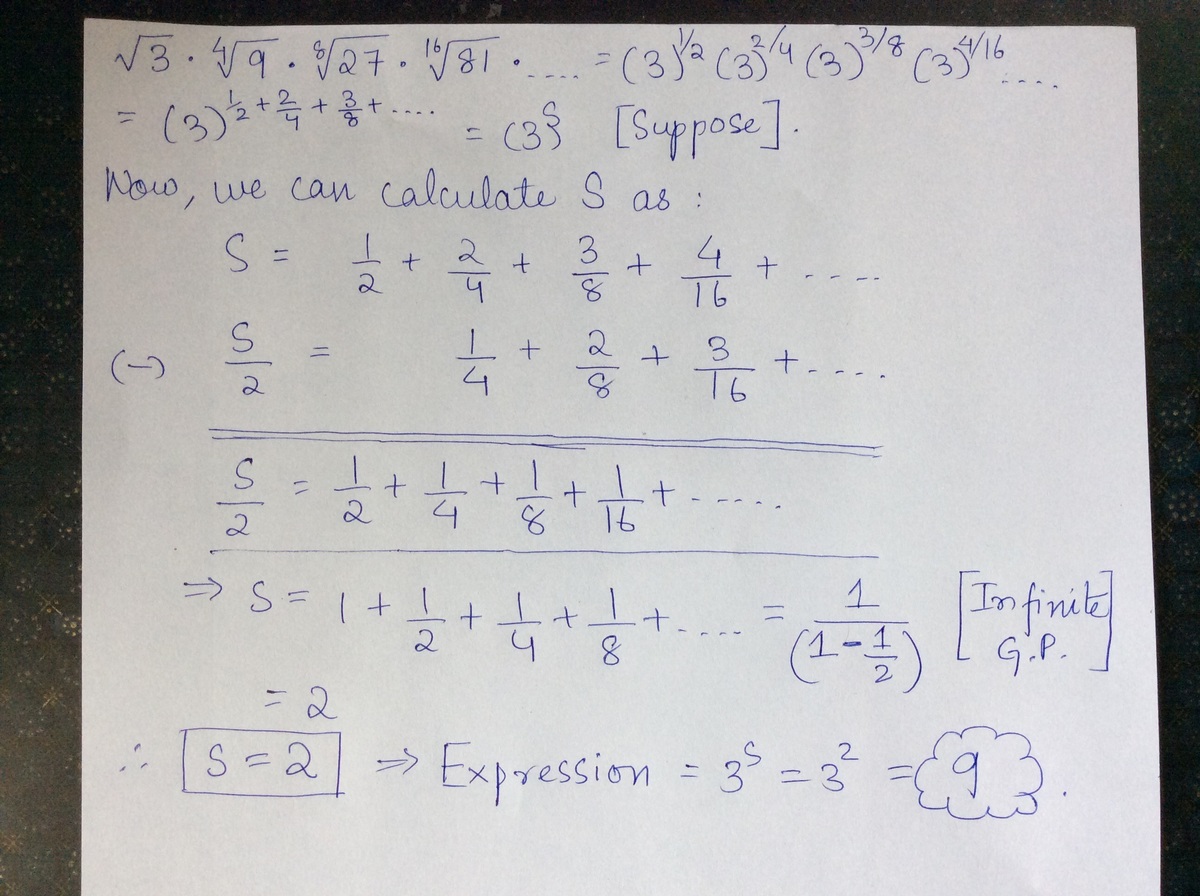G.P.'s Power is G.P. itself
3 ⋅ 4 9 ⋅ 8 2 7 ⋅ 1 6 8 1 ⋯ = ?
You can try my other Sequences And Series problems by clicking here : Part II and here : Part I.
The answer is 9.
This section requires Javascript.
You are seeing this because something didn't load right. We suggest you, (a) try
refreshing the page, (b) enabling javascript if it is disabled on your browser and,
finally, (c)
loading the
non-javascript version of this page
. We're sorry about the hassle.
3 solutions
Moderator note:
It's always good to be familiar with the various ways of calculating an Arithmetic-Geometric Sum .
Thanks a lot. I didn't know about it.
Let us write the product like this:
3 ( 2 1 ) . 3 ( 4 2 ) . 3 ( 8 3 ) . 3 ( 1 6 4 ) . . . = 3 ( 2 1 + 4 2 + 8 3 + 1 6 4 + . . . ) = 3 ( 1 × 2 1 + 2 × 4 1 + 3 × 8 1 + 4 × 1 6 1 + . . . )
So we need to evaluate the following infinite sum:
1 × 2 1 + 2 × 4 1 + 3 × 8 1 + 4 × 1 6 1 . . .
We find that we have an Arithmetic Progression with first term ( a = 1 ) and difference ( d = 1 ) .
We also have a Geometric progression with first term ( b = 2 1 ) and ratio ( r = 2 1 )
We observe that this is an Arithmetic-o-geometric progression whose infinite sum is given by :
1 − r a b + ( 1 − r ) 2 d b r
Substituting the given values we have:
( 1 − 2 1 ) ( 1 ) ( 2 1 ) + ( 1 − 2 1 ) 2 ( 1 ) ( 2 1 ) ( 2 1 ) = ( 2 1 ) ( 2 1 ) + ( 2 1 ) 2 ( 2 1 ) 2 = 1 + 1 = 2
So the given sum = 3 2 = 9
Moderator note:
Good explanation of how to deal with the arithmetic-geometric progression.

Slightly different from Nihar Mahajan 's solution.
Let x = 3 4 9 8 2 7 1 6 8 1 . . . = 3 2 1 3 4 2 3 8 3 3 1 6 4 . . . = 3 2 1 + 4 2 + 8 3 + 1 6 4 + . . . = 3 ∑ k = 1 ∞ 2 k k
We note that:
S S = k = 1 ∑ ∞ 2 k k = k = 0 ∑ ∞ 2 k k = k = 1 ∑ ∞ 2 k k = k = 0 ∑ ∞ 2 k + 1 k + 1
Now, we have:
S = 2 S − S = 2 k = 0 ∑ ∞ 2 k + 1 k + 1 − k = 0 ∑ ∞ 2 k k = k = 0 ∑ ∞ 2 k k + 1 − k = 0 ∑ ∞ 2 k k = k = 0 ∑ ∞ 2 k 1 = 1 − 2 1 1 = 2
⇒ x = 3 S = 3 2 = 9